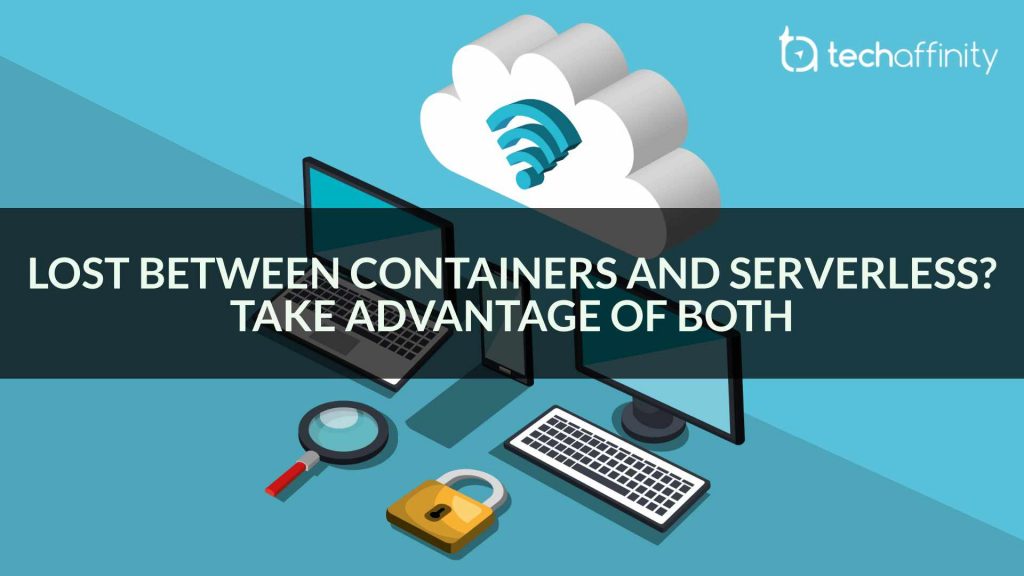Lost Between Containers and Serverless? Take Advantage of Both!

Author : John Prabhu 26th Nov 2020
Containers and Serverless technologies are considered to be competitors in the IT services industry. Undeniably, both are the talk of the town in this era of technology. Both of the technologies are device agnostic and immensely productive abstractions for developers/software engineers to work with.

Certainly, there are huge differences between containers and serverless computing. If you are planning to couple these two technologies, you are more likely to get the most out of this powerful combination.
WHAT IS A CONTAINER MICROSERVICE?
Container microservice or container technology helps to package an application in such a way that it can run in an isolated environment with its dependencies. Popular cloud computing providers such as Microsoft Azure, AWS, and Google Cloud Platform (GCP) have opted for container technology with the popular choices of Docker, Kubernetes, Apache Mesos, and more.
Simply put, container microservices are isolated packages, wherein apps are deployed, executed, and scaled.
The on-demand cloud computing platform provider Amazon defined, “Containers are a method of operating system virtualization that allows you to run an application in resource isolated processes.”
The container management platform, Docker defined, “Containers to be a unit of software that packages up the code and all its dependencies, so the application runs quickly and reliably from one computing environment to another.”
While migrating from one platform to another, containers make the transition more simple and easy. It is so because containers have the potential to implement isolation during migration to prevent any variable alterations.
Therefore, you can go ahead with containers when you want to move your designed product code from development to staging to production.
TRENDS IN CONTAINER TECHNOLOGY
- The predicted growth of container technology in the year 2020 is up to $3 billion.
- Between 2016 and 2017, the market for the container as a service rose to 40%.
- In 2017, around 32% of businesses spent $500,000+ on the container technology license and usage fees.
- The demand for containers is expected to grow by 40% by 2021.
WHY CHOOSE CONTAINER TECHNOLOGY?
There are a plethora of advantages associated with the choice of containers. Some advantages are discussed below.
1. HELPS YOU GO BIG
With serverless computing, you might have to go through code sprawls often and managing them is tough. Hence, when you know and understand the nuances of container technology, you would rather opt for containers as it is a wonderful option for large enterprise or broader applications.
2. OFFERS FULL CONTROL FOR DOCKERS
With dockers, you get the ownership and are entitled to set policies, manage and reserve resources, have greater control over security, and make full use of container-management and migration services.
You can customize the functionalities pertaining to your requirements as you have control over basic infrastructure commands.
3. ENABLES YOU TO TEST, DEBUG, AND MONITOR
Manual inspection of the on-off container activities and status helps in ensuring effective testing and deep debugging by leveraging a wide range of resources. It also helps in end-to-end monitoring of performance at various levels.
4. WHAT SETS CONTAINERS A CLASS APART FROM SERVERLESS?
The advantage of using containers is that it offers exclusive portability. It allows you to combine all the apps along with their dependencies in a little isolated package and execute it anywhere. Since containers don’t impose any size or memory constraints, containers are a great deal for larger apps.
WHAT IS SERVERLESS COMPUTING?
Serverless computing is an execution model for cloud-computing where the cloud service provider handles the servers, and dynamically controls & manages the allocation of machine resources. Interestingly, the pricing is based on the total amount of resources consumed and not on pre-purchased units of capacity. Simply put, serverless computing is a subset of cloud computing services, running on servers.
TRENDS IN SERVERLESS COMPUTING
- It is predicted that the serverless computing would grow up to $7.72 billion by 2021.
- In the previous year, serverless computing has been estimated to be $4.25 billion. At a Compound Annual Growth Rate (CAGR) of 28.6%, it is predicted to reach $14.93 billion by 2023.
WHY SERVERLESS COMPUTING IS BETTER?
While you can focus on writing and deploying the code to your serverless service provider manages the operational infrastructure requirements. Hence, you can save and effectively utilize the development time to a greater extent.
Some of the leading Serverless computing service providers include Google Cloud Platform (GCP), AWS Lambda, EdgeEngine, etc. They offer a runtime environment where you can deploy your codes, and all other functions are managed by the service providers.
WHY SHOULD YOU SWITCH FROM CONTAINERS TO SERVERLESS?
1. REDUCED COST
You get idle resources on exempted pricing, and also you only pay per usage. For instance, the recurrence of the milestone of timings with AWS Lambda (an event-driven, serverless computing platform), has a range of 100 milliseconds.
Since the tasks are relatively short and run on shorter serverless functions, there is a reduction in the overhead cost.
2. COMPARATIVELY LOW MAINTENANCE
As you have the automatic scaling option, the container provisioning, system policies, deployment of code, availability levels, and even the back-end server tasks are not your attention-grabbing priorities anymore.
3. SIMPLE & COGNITIVE PROTOTYPE
With serverless computing, any possibilities of run time crashes/failures of your container’s lifecycle are completely avoided. It is so because serverless is an external integration when mainframe application environment is taken into consideration.
4. IMPROVED LATENCY
Serverless architectures usually have access points on a global scale. That means that it’ll be easier to handle users from every corner of the world. This way, you can scale without affecting the performance of your application. As an example, imagine that you host a server the traditional way on the West Coast. If a user from the East Coast uses your app, they’d have to send a request the entire distance and back. For a serverless architecture, it would only go as far as the closest serverless node, which might be on the West Coast! The only potential downside is cold starts, which is the ramp-up time for an app to build and to be placed in a container.
SCENARIOS WHERE YOU SHOULD GO WITH SERVERLESS COMPUTING
1. PERFORMING BACK-END TASKS FOR WEBSITE AND APPS
Similar to the server-backed computing, serverless also receive, store and, read information from the database or the website or the UI of user app. Following the procedure, it retrieves the data and delivers it to the user interface.
When it comes to pricing, unlike the containers, you pay only for the actual back-end task execution duration with serverless computing.
2. HIGH VOLUME BACKGROUND PROCESSES
You can easily organize the inventory and transaction database of a point of sale (PoS) system using serverless functions. Also, by taking advantage of serverless functions, seasonal tasks such as re-stocking can be performed.
An even more attractive feature is that serverless helps a lot in the transition of data to long term storage or send metrics to analytics service.
A CLOSER LOOK AT CONTAINERS AND SERVERLESS COMPUTING
Containers are generally preferred when your app is going to be complex and large. If you design your app in an environmentally sensitive way, your app would demand rigorous monitoring and quality assurance. Hence, the container is your best pal.
Containers offer greater support and make it easy when there comes a need to migrate monolithic legacy applications. You can easily split the large monolithic apps into smaller containers and install them with third-party tools.
Containers go well with larger websites such as eCommerce – a site with numerous subdomains and sitemap. You can take maximum advantage of containers to package and independently-run each in separate containers.
So, when your product doesn’t need much of migration, you are good to go ahead with serverless computing for a new project. Let’s assume the scenario of Internet of Things (IoT) apps in a refrigerator. Serverless works well with the apps supporting IoT and diagnose the presence of water in the first place. The diagnosis helps in identifying water leakage in the water storage compartment.
In this case, your app doesn’t have to run throughout the day but only when there occurs a leakage.
Hence, serverless computing is your perfect choice when cost minimization and development speed are the key metrics, and you don’t want to break your head to meet the increasing demand and manage scalability.
HYBRID MODEL
Are you still lost between containers and serverless computing? Currently, you can leverage both of these technologies for the same development project but different requirements. Containers offer higher scalability and independence on technical specifications; whereas serverless computing is a great choice for event-driven triggers for data processing.
By making the containers a subset of the entire project running on a serverless platform, you can take the complete advantage of containers and serverless computing. Thus, the containers help you manage every bits and piece of your project. Ultimately, it all depends on your project needs and budget constraints.
FINAL THOUGHTS
As said earlier, in the ever-dynamic landscape of IT services, containers and serverless computing are the competitors. They are the contemporaries now, and they are the reason behind the existence of the dynamic cloud technology and continuous delivery based software. So, if you want to overcome the disadvantages of both, it is strongly suggested for you to integrate both of these and take the advantages of both.
We, at TechAffinity, have been thriving in the IT services industry for a long time now and have very well handled the platform integration requirements. Our experts are capable of handling platform integration services with ease. Get in touch with us and share your queries with us and we will suggest the best solution for your requirements. You can drop a mail at media@techaffinity.com with all your queries.
